The First Viola da gamba
Fresco cycle of the Cathedral of Valencia (1472-74)
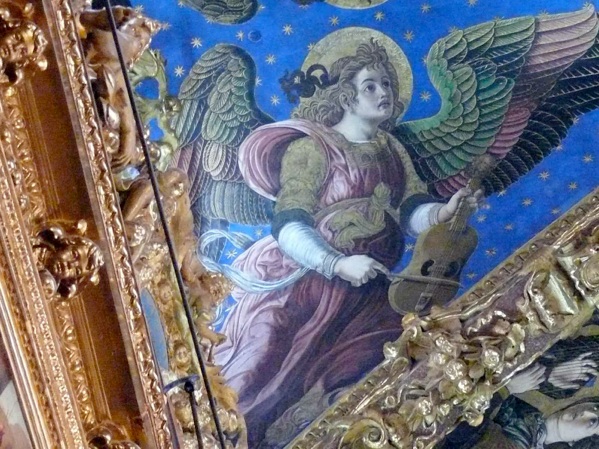
Introduction by Andrew Ashbee:
On 21 May 1462, around two hundred years after the cathedral was begun, what was described as ‘a “burning” pigeon, representing the Holy Spirit’, descended from the dome, setting light to the cloth around the wooden and silver altarpiece and destroying the decoration of the apse and the frescoes in the vault. Attempts at restoration failed, so, as José records, some ten years later two artists were commissioned to paint new frescoes. The contract survives and shows that in each space between the ribs of the vault they were to paint two angels, dressed as directed by the honourable Chapter, with golden wings in exquisite colours; to decorate the ribs with branches, leaves and fruits, painted with gold of ducats and to paint the windows in azure and gold of ducats too.
All this was hidden when a new baroque ceiling was built between 1674 and 1682 under the direction of the architect Juan Pérez Castiel. Work began on restoring this in May 2004. Pigeons had been heard behind the façade and a hole was made in the course of establishing the scaffolding. On 22 June a digital camera was poked through to investigate if anything could be seen. Part of the fifteenth-century painting was revealed, which unusually had not been destroyed but merely covered up by a false ceiling. The decision had to be made as to whether the renaissance or baroque work should be retained. It was subsequently decided that the frescoes should be preserved in situ and that the baroque replacements should be removed. (AA)
Blessed Wings
During the restoration of the Baroque frescoes of the vaulted ceiling of the Valencia Cathedral, the workers perceived a flattering of winged beings through the wall. “Pidgeons”, they thought. I, however, judging by the astounding revelation that ensued and was made manifest unto us, suspect in this incident a further manifestation of the Holy Spirit
Their curiosity having been thus evoked, the craftsmen bored a hole through the wall, threw light into the hollow cavity and were overcome with great astonishment: what their ray of light encountered is recognised today to be the most outstanding example of Italian Renaissance fresco painting in the entire Iberian Peninsula! A series of winged beings are portrayed: angels in precious garments, each with a musical instrument, finely wrought in meticulous detail. Praise be to God, for behold, these frescoes, in their utter perfection , represent an iconographic monument of unspeakable worth
Owing to the erection of a second ceiling in 1674, decorated with Baroque paintings, these Renaissance frescoes, now harboured in that cavity affording total darkness, have been miraculously conserved during the last 330 years in practically immaculate condition. The execution of this cycle of frescoes was entrusted to Francesco Pagano (from Naples) and Paolo di San Leocadio (from Reggio, Lombardy), two outstanding Italian artists. This was through the intervention of Rodrigo Borja, “our” Rodrigo Borgia (Italianised version of the name), who later became Pope Alexander VI. Rodrigo, a native of Xativa, is responsible for the introduction of the viola da gamba in Italy: the newly-elected pope brought his complete musical chapel in his entourage when he took up residence in the Vatican. The rest is history.
Of critical importance is the representation of two historically closely related instruments: the vihuela de mano and the vihuela de arco. The first shows a remarkable similarity with the depiction of a viola da gamba in Sebastian Virdung’s “Musica getutsch und außgezogen” (Basel, 1511) which appeared almost unchanged shortly afterwards in Martin Agricola’s “Musica instrumentalis deudsch” (1529).
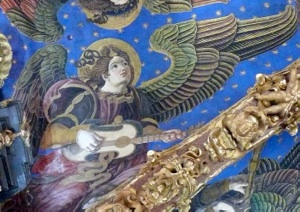
Vihuela de mano, Cathedral of Valencia

Groß Geigen, Sebastian Virdung “Musica getutsch und außgezogen”, Basel, 1511
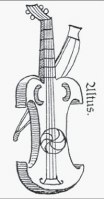
Viola da gamba, Martin Agricola “Musica instrumentalis deutsch, 1529
Interesting for us is the portrayal of the viola da gamba, which, in view of the very early date of the painting (1472), must be seen as the very first iconographical evidence of a viola da gamba in history. Until this recent discovery (2004), the earliest known representation was the magnificent altar painting by Valentin Montoliu (1475-85) in the Heremitage of St. Feliu (St. Félix) in Xàtiva (near Valencia, Spain; see below). The viola da gamba of the Valencia Cathedral derives its form from the guitar, and viols of this form are also found in other pictorial representations in the region of Valencia around 1500. Viols in guitar-form were built in Italy from the 16th Century until, astonishing as this may seem, the middle of the 18th Century. Famous violin makers like Gasparo da Salò, Grancino, Testore, Guarneri employed this form in building their viols, though not to the exclusion of others. A tenor viola da gamba by da Salò and a bass by Paolo Antonio Testore (1717) can be seen here: www.orpheon.org.
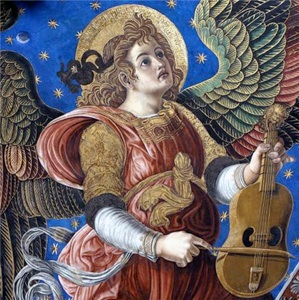
Vihuela de Arco, Cathedral of Valencia
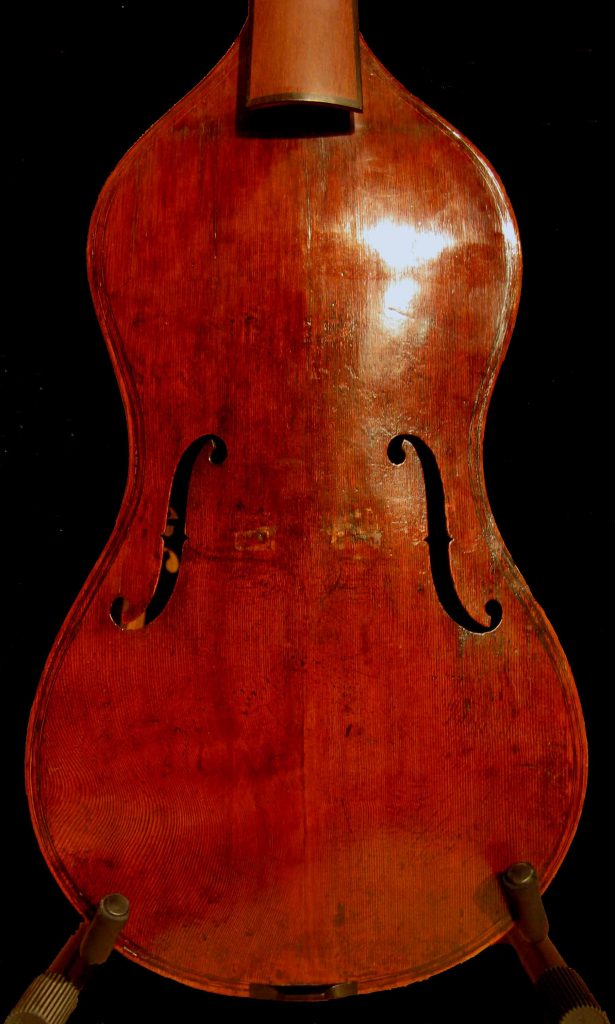
Viola da gamba (Tenor) by Gasparo da Salò, Brescia, ca. 1570
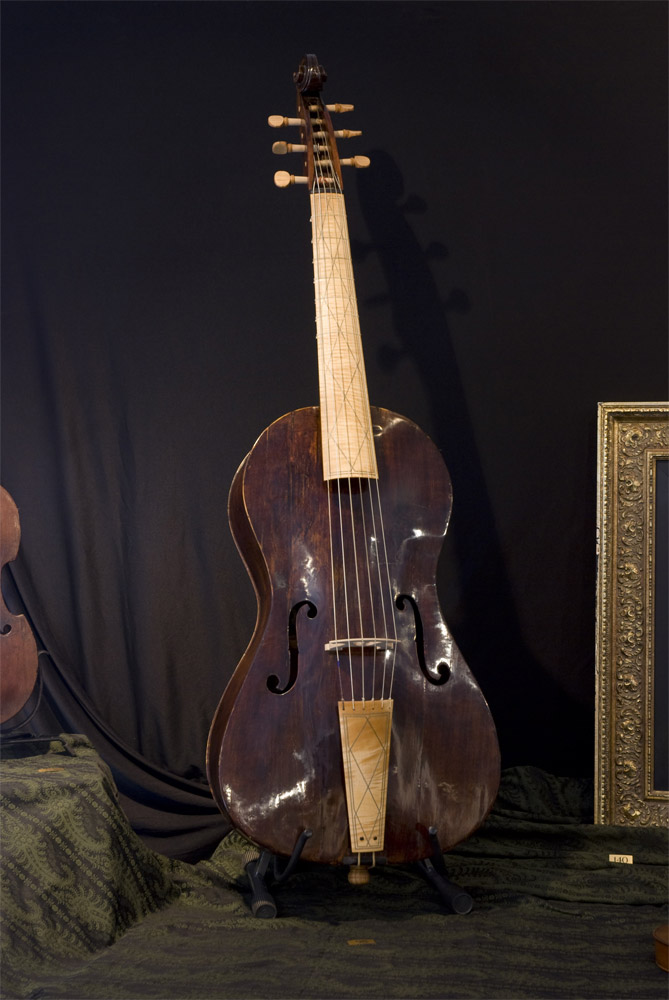
Viola da gamba von Paolo Testore, Milano, 1717
Since the early Medieval Period, in the 10th Century, a high musical culture established itself in the Caliphat of Cordoba, whose creations were appreciated not only all over Spain, but also in the entire Arabian World. Contemporary Christian chronicles report that the Spanish courts regularly employed Arabian musicians for their feasts and ceremonies, often making them travel long distances, in order to supply the necessary musical entertainment at particularly important events. During the 14th and 15th Centuries the chronicles singled out the Arabian musical families of Xativa and Valencia for praise, who were entrusted with all musical activities for the feasts in, among others, Barcelona, Zaragoza, even as far away as Perpignan. Indeed, these musicians were handsomely paid by the Spanish monarchs (Alas, those wonderful times of old!). It should therefore be of no surprise that the developments in the construction of musical instruments in this region would be particularly prominent. It is generally known that the vihuela de mano and vihuela de arco were invented in this region. But did you know that, quite probably, one of these families, through the overzealous religious persecutions of 1492 now transformed into “winged beings” and forced to seek refuge on foreign soil, founded the violin-making tradition in Cremona? Acording to a French researcher, Christian Rault, Andrea Amati, who signed his first violins with “Amadi” (a name not found in Italy, but encountered in Valencia: Amadi, Hamad), quite probably came from the same region as the inventor of the viola da gamba. But this should be the subject of another story…
A closing remark:
It could well be, that these people are not allowed to erect minarets on Christian soil, neither in the past nor the present, but, please, let them nevertheless at least build our instruments.
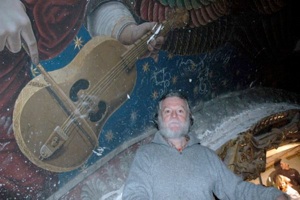
Vicent Ferrus Mascarell, 2004, at the moment of the discovery of the frescoes on the ceiling of the Cathedral. Note the relative sizes!
NB: The information for this article was supplied in part by Vicent Ferrus Mascarell, who witnessed the discovery and subsequent study of the frescoes. This photo, taken at that time (2004), demonstrate the colossal proportions of the figures. The angels are about 4 meters tall!
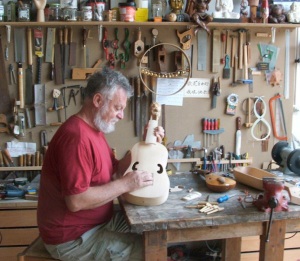
Vicent Ferrus Mascarell in hid atelier, working on the reconstruction of the viola da gamba
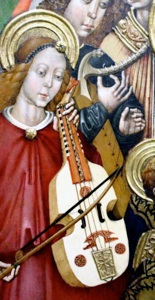
Viola da gamba, Valentin Montoliu (1475-85), Hermitage of St. Feliu (St. Félix) in Xàtiva (near Valencia, Spain)
This painting was long considered to be the earliest depiction of a viola da gamba in history, until the discovery of the frescoes of the Valencia Cathedral.
José Vázquez
(Documentation and some photos were kindly made available by Vicent Ferrus Mascarell)